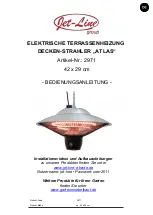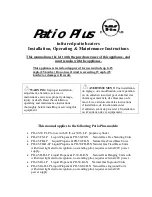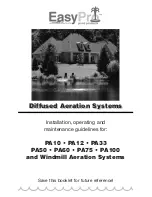
57
17.0
MAINTENANCE
17.1
GENERAL
Keep appliance area clear and free from combustible materials and flammable vapours and liquids.
A competent person should check and ensure that the flue, its support and terminal, the ventilation to the boiler house, safety valve, drain,
pressure gauge etc. are in a serviceable and working condition and still comply with the relevant standards and codes of practice, as detailed in
Section 6.0: GENERAL REQUIREMENTS.
Servicing is recommended at intervals no greater than 12 months to ensure trouble free operation. Even if the maintenance schedule for the
storage vessel is determined to be less than annually, it is important that all controls and safety features are checked for correct operation on an
annual basis.
Measuring flue gas CO
2
and flue gas temperatures will give an indication of the state of the flue and burner. Results of the flue gas analysis
should be compared with previously measured values to identify a possible loss of efficiency.
17.2
BURNER INSPECTION
The heat exchanger has a sight glass for inspection of the flame picture.
If the appliance has been in recent operation, this area may be hot. Appropriate precautions should be taken to
prevent personal injury.
To check the flame picture at high and low fire, the following procedure should be followed:
1.
Place the water heater into service mode. To access the service mode press and hold the Enter and Up buttons simultaneously for
5 seconds.
2.
The heater should ramp up to full firing rate
3.
Check the flame condition.
4.
Press the Enter button momentarily, this should ramp the water heater down to low rate.
5.
Check the flame condition.
6.
Press and hold the Enter button for 5 seconds to take the unit out of service mode.
17.3
BURNER REMOVAL
If it has been determined that the flame picture is unacceptable, the burner can be removed and cleaned using the following procedure:
1.
Isolate the electrical and gas supplies to the heater.
2.
Allow the boiler to cool down.
3.
Disconnect the wiring connections to the ignition electrode.
4.
Disconnect the power and control connection leads and earthing wire from the combustion fan.
5.
Apply suitable release oil to the 6 studs around the edge of burner door.
6.
Remove the 6 retaining nuts around the edge of the burner door.
Once loosened, the nuts should be removed by hand. If any of the nuts seize, the nut should gently be re-tightened
and additional release oil used.
7.
Withdraw the heat exchanger front plate and burner assembly from the heat exchanger complete with the combustion fan.
8.
With the burner assembly away from the boiler, the burner can be gently cleaned with the brush attachment of a vacuum cleaner.
The reassembly procedure is the reverse of the above taking care to ensure that the for the heat exchanger front plate sealing gasket, the
combustion fan connection gasket, the burner door insulation and the combustion chamber rear wall insulation are in good condition or are
replaced as necessary.
Note: particular attention should be paid to the combustion chamber rear wall insulation. If any
deterioration in the insulating material is noted, the insulation panel must be replaced.
Summary of Contents for EcoShield SHW116-410CE
Page 2: ...2 ...
Page 9: ...9 EXPLODED VIEW DRAWINGS ...
Page 27: ...27 Max distance between brackets ...
Page 28: ...28 ...
Page 29: ...29 ...
Page 34: ...34 ...
Page 47: ...47 13 9 LADDER DIAGRAM LADDER DIAGRAM ...
Page 71: ...71 NOTES ...
Page 72: ...72 N ...
















































